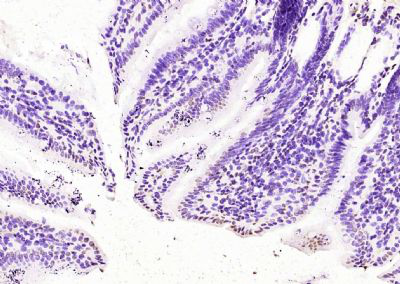产品货号 : mlR8385
英文名称 : UBE2W
中文名称 : 泛素蛋白连接酶W抗体
别 名 : hUBC 16; hUBC16; Probable ubiquitin conjugating enzyme E2 W; Probable ubiquitin-conjugating enzyme E2 W; UBE 2W; ube2w; UBE2W_HUMAN; Ubiquitin carrier protein W; Ubiquitin conjugating enzyme 16; Ubiquitin conjugating enzyme E2 W; Ubiquitin conjugating enzyme E2W; Ubiquitin protein ligase W; Ubiquitin-protein ligase W; FLJ11011.
研究领域 : 细胞生物 免疫学 信号转导 表观遗传学
抗体来源 : Rabbit
克隆类型 : Polyclonal
交叉反应 : Human, Mouse, Rat, Chicken, Dog, Pig, Cow, Horse, Rabbit, Sheep,
产品应用 : ELISA=1:500-1000 IHC-P=1:400-800 IHC-F=1:400-800 IF=1:50-200 (石蜡切片需做抗原修复)
not yet tested in other applications.
optimal dilutions/concentrations should be determined by the end user.
分 子 量 : 17kDa
细胞定位 : 细胞核
性 状 : Lyophilized or Liquid
浓 度 : 1mg/ml
免 疫 原 : KLH conjugated synthetic peptide derived from human UBE2W:71-151/151
亚 型 : IgG
纯化方法 : affinity purified by Protein A
储 存 液 : 0.01M TBS(pH7.4) with 1% BSA, 0.03% Proclin300 and 50% Glycerol.
保存条件 : Store at -20 °C for one year. Avoid repeated freeze/thaw cycles. The lyophilized antibody is stable at room temperature for at least one month and for greater than a year when kept at -20°C. When reconstituted in sterile pH 7.4 0.01M PBS or diluent of antibody the antibody is stable for at least two weeks at 2-4 °C.
PubMed : PubMed
产品介绍 : Ubiquitin is an abundant, highly conserved protein found in all eukaryotic cells either free or covalently attached to cellular proteins. Ubiquitination is an important mechanism through which three classes of enzymes act in concert to target short-lived or abnormal proteins for destruction. The three classes of enzymes involved in ubiquitination are the ubiquitin-activating enzymes (E1s), the ubiquitin-conjugating enzymes (E2s) and the ubiquitin-protein ligases (E3s). As an E2 class enzyme, UBE2W (Ubiquitin-conjugating enzyme E2 W), also known as Ubiquitin carrier protein W, is a 151 amino acid that catalyzes the conjugation of ubiquitin to proteins that are meant for lysosomal degradation. Functioning as a homodimer, UBE2W is widely expressed, with highest levels in testis. There are two isoforms of UBE2W that are produced as a result of alternative splicing events.
Function:
Accepts ubiquitin from the E1 complex and catalyzes its covalent attachment to other proteins. Catalyzes monoubiquitination. Involved in degradation of misfolded chaperone substrates by mediating monoubiquitination of STUB1/CHIP, leading to recruitment of ATXN3 to monoubiquitinated STUB1/CHIP, and restriction of the length of ubiquitin chain attached to STUB1/CHIP substrates by ATXN3. After UV irradiation, but not after mitomycin-C (MMC) treatment, acts as a specific E2 ubiquitin-conjugating enzyme for the Fanconi anemia complex by associating with E3 ubiquitin-protein ligase FANCL and catalyzing monoubiquitination of FANCD2, a key step in the DNA damage pathway. In vitro catalyzes 'Lys-11'-linked polyubiquitination.
Subunit:
Homodimer. Interacts with FANCL. Interacts with STUB1/CHIP (By similarity).
Subcellular Location:
Nucleus. Note=In the nucleus, colocalizes with FANCL.
Tissue Specificity:
Widely expressed, with highest expression in brain, liver, pancreas and heart.
Post-translational modifications:
Ubiquitinated in vitro in the presence of FANCL (By similarity).
Similarity:
Belongs to the ubiquitin-conjugating enzyme family.
SWISS:
Q96B02
Gene ID:
55284
Important Note:
This product as supplied is intended for research use only, not for use in human, therapeutic or diagnostic applications.
产品图片












